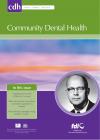Community Dental Health

- Cover Date:
- March 2010
- Print ISSN:
- 0265 539X
- Vol:
- 27
- Issue:
- 1
The influence of economic incentives on treatment patterns in a third-party funded dental service
Objective: To investigate the response of dental practitioners to administration and remuneration adjustments to the Dental Treatment Services Scheme (DTSS) in the Republic of Ireland. Design:   Following the introduction of a series of administration and fee adjustments by a third party payments system in December 1999 the pattern of extractions and restorations are examined to determine whether the adjustments had influenced provider behaviour, in particular whether a substitution effect from extractions to restorations would result from a relative fee increase of 62% for amalgam fillings. Data  and  Methods:  Data on patient and provider characteristics from June 1996 to April 2005, collected by the Health Service Executive (HSE) National Shared Services Primary Care Reimbursement Service to facilitate remuneration to dentists providing services in the DTSS, was used in this analysis. A graphical analysis of the data revealed a structural break in the time-series and an apparent substitution to amalgam fillings following the introduction of the fee increases. To test the statistical significance of this break, the ratio of amalgams to restorations was regressed on the trend, growth and level dummy variables, using Ordinary Least Squares (OLS) regression. The diagnostics of the model were assessed using the Jarque-Bera normality test and the LM to test for serial correlation. Results:  The initial results showed no evidence of a structural break. However on further investigation, when a pulse dummy was included to account for the immediate impact of the fee adjustment the results suggest a unit root process with a structural break in December 1999. This implies that the amalgam fee increase of December 1999 influenced the behaviour patterns of providers. Conclusions: System changes can be used to change the emphasis from a scheme that was principally exodontia/emergency based to a scheme that is more conservative and based on restoration/prevention.
Key words: Economic incentives, 3rd party payments system, restoration/prevention, substitution effect, structural break.
- Article Price
- £15.00
- Institution Article Price
- £
- Page Start
- 18
- Page End
- 22
- Authors
- N. Woods, J. Considine, S. Lucey, H. Whelton, T. Nyhan
Articles from this issue
- Title
- Pg. Start
- Pg. End
- The influence of economic incentives on treatment patterns in a third-party funded dental service
- 18
- 22
- Is tooth wear in the primary dentition predictive of tooth wear in the permanent dentition? Report from a longitudinal study.
- 41
- 45
- Chewing stick use among African immigrants in West Philadelphia: implications for oral health providers
- 60
- 64
